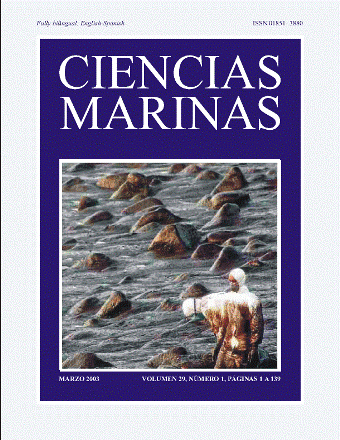Fatty acids in plasma of California sea lion pups (Zalophus c. californianus) from Los Islotes, Baja California Sur, Mexico
Main Article Content
Abstract
Nutritious fats include all the lipids ingested as food and are composed mainly of triglycerides mixed with smaller quantities of other lipids. Fatty acids (FA) constitute the part of most nutritious interest in triglycerides. The fatty acid composition was assesed in the blood plasma of California sea lion pups (Zalophus c. californianus) from Los Islotes, Baja California Sur, in the Gulf of California, during 1999. Blood samples were obtained from 35 anesthetized sea lion pups, 21 males (M) and 14 females (F). The plasma was separated by centrifugation and stored with different antioxidants. The FA profile was determined by gas chromatography with flame ionization detection (FID). There was a great variation both in presence and quantity of fatty acids (FA) among animals. The sea lion with the least number of FA had 12 and the one with the most had 29 FA. Twelve saturated FA (SFA) were identified, 9 monounsaturated (MUFA) and 10 poly unsaturated (PUFA). The most frequent SFA in both groups were C14:0, C16:0 and C18:0, and the most abundant ones were: C15:0 (10.4 and 13.7 mg/100mL, in M and F respectively) and C18:0 (4.3 and 6.1, respectively). C16:1, C17:1 and C18:1n-9t were the most frequent MUFA, ant the most abundant ones were C17:1 and C24:1 (3.2 and 3.5, and 3.3 and 2.9 mg/100mL in M and F, respectively). C15:1 was very abundant in females (5.4 mg/ 100mL) when compared with males (0.91), and was the only one of all the FA identified showing a statistical difference P < 0.05. The most abundant MUFA was C18:1n-9t (10.6 and 7.8 mg/100 mL, in M and F respectively). In both groups the most frequent PUFA detected were C18:2n-6t, C22:2, C:22:6n-3 and C20:3n-6, showing the latter the highest concentration (20.3 and 26.5 mg/ 100mL, in M and F respectively). The 20:3 n-3 was identified only in two males. The SFA with the lowest concentration was C12:0 (0.030 and 0.45 mg/100 mL), and C11:0 was detected only in five animals. Four n-6FA (C18:2, C18:3, C20:3 and C20:4) and three n-3FA (C20:3, C20:5 and C22:6) were identified. Two trans-FA were also identified, C18:1t and C18:2t. The FA values were very heterogeneous so in females as in males, probably influenced by different fasting periods of the pups. Given that during the sampling period the body condition of pups was within the normal values estimated for the Gulf of California, the plasmatic FA values of the pups can be used as reference values regarding other populations.
Downloads
Article Details
This is an open access article distributed under a Creative Commons Attribution 4.0 License, which allows you to share and adapt the work, as long as you give appropriate credit to the original author(s) and the source, provide a link to the Creative Commons license, and indicate if changes were made. Figures, tables and other elements in the article are included in the article’s CC BY 4.0 license, unless otherwise indicated. The journal title is protected by copyrights and not subject to this license. Full license deed can be viewed here.

